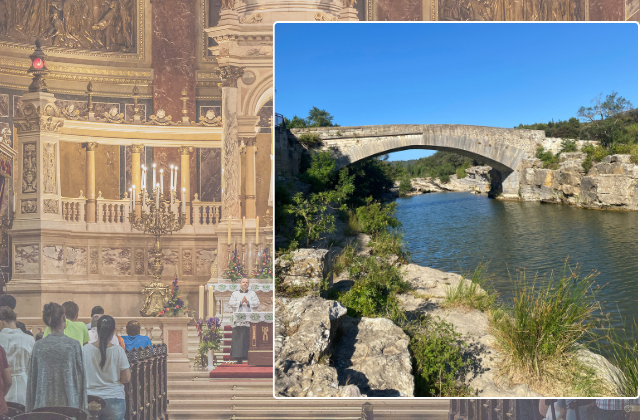Last Sunday I went to High Mass. I am a non-Christian, let alone a Catholic, from an agnostic and political background, so this was an odd move.
There were extenuating circumstances: we had holiday visitors, the Mass was held in the Romanesque Abbaye de Sainte-Marie in Lagrasse, a beautifully preserved medieval village in the Languedoc, and my sister-in-law wanted to go. And, I confess (in the secular use of the word), that Gregorian chant is always tempting…
I was hesitant – would it be rude or even blasphemous to attend as a non-believer? Two of our party were brought up as strict Catholic boys – long lapsed but knowledgeable. Not at all they assured me: another soul to save. I was nonetheless uncomfortable: was this just another experience on the experience-bucket-list?
We sat near the back. The massive, undecorated church was packed. Visitors and locals in their Sunday best. It was the fifth Sunday after Pentecost with themes of hope, compassionate love, and steadfast trust in God.
The ritual theatre was impressive, the Canons Regular of St Augustine dignified in their white surplices, the Priests, Deacon and Sub-Deacon solemn in white, green and gold, different ranks adorned with a purple cap (what I now know to be a ‘mozzetta’) and a fine-boned, blond-headed altar boy, an angel, surely no more than eight years old, seemed terribly vulnerable by the side of the strikingly tall monks.
Much swinging of thuribles from which clouds of incense burst and rose like dry ice, swirling around the ceremony and filling the church with the smell of holy ritual; prayers (in Latin), a sermon on hopefulness (in French – bizarrely involving a tasteless mother-in-law joke) and yes, sublime Gregorian chant to lift the heart to the heights of the Romanesque vaulted roof.
Over the course of 90 minutes the congregation knelt and stood, bowed their heads, repeated their lines in call and response. Some left to say confession, returned, knelt and stood, repeated their lines. I was struck by the devotional expression of a young woman near us – her eyes wide and radiant, her head tipped upwards to receive the divine, and by the ranks of respectful devotion…
I found myself drifting off, soothed by the incantations, held by the containment of ritual, suspended in a soporific trance. After an hour I started to feel queasy. Perhaps it was the incense, the lack of fresh air. While the congregation emerged happy and chatty, I experienced a sudden relief in regaining the fresh air – and my mind. It seemed to me – an outsider – that the whole thing is designed for obedience and submission. The trance-inducing ritual is meant precisely to do just that.
Docile acquiescence to a higher authority can be comforting – I got it, I felt it – but it trains us in habitual behaviours (algorithmically enhanced today) that take us down a pathway of passivity and knee-jerk reactivity. We learn not to think for ourselves.
I was shaken by the experience and reflected that Catholic High Mass could not be further from the kind of spirituality we explore in our work.
‘Explore’ is the operative word here. I started talking about ‘Everyday Spirituality’ in 2017 in my book The Future of Coaching – my aim, born of a frustration living in a world devoted to consumerism and personal power, was to reclaim the spirit from the preserve of organised religion and its dogma.
Spirit is a wonderful word, full of vitality: we talk of a horse being spirited, of the spirit of a place being strong, of being inspired by a person, event or landscape. It seems to me this is the opposite of what I experienced on Sunday. Can we, I want to know, bring some of this flame, some spirit, into our everyday lives?
Can we infuse our journey through life with a sense of purpose? Can we bring meaning to everyday actions, to our work, and interactions with others, beyond the transactional?
What would it mean to feel part of something bigger than our individual desires? Like the mycorrhizal network of roots and fungi that nourish a forest of trees, or the flow of a river, constant and seamless, can we understand our lives as part of an interconnected ecosystem of invisible yet tangible connections, interdependent with the fragile beauty of our planet?
And how might we behave if we believed that each of us too, has a flame inside, an essence that persists through all our changing roles and the vagaries of life, nourished both from within and from without?
These are questions we hold for collective enquiry. Never pinned down, never enshrined in dogma. No incense, no trances!
We invite participants to bring their thoughtfulness, their multiple intelligences, their love, energy and will – as well as their spirit – to this work. Because it is this that enables us to coach and lead beyond immediate goals and look at the why, the wherefore, and practical how, of engaging with challenges.
This is my understanding of everyday spirituality.

